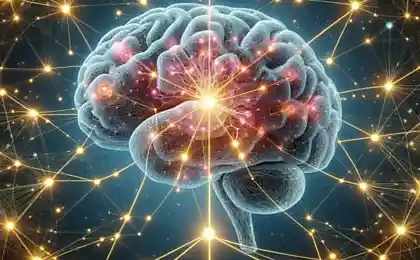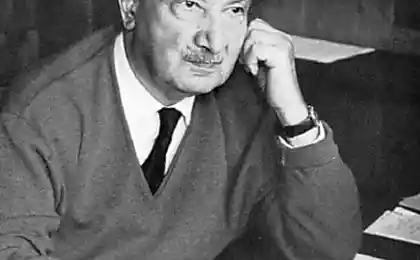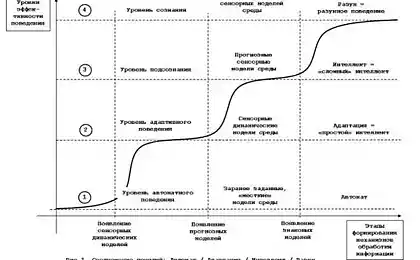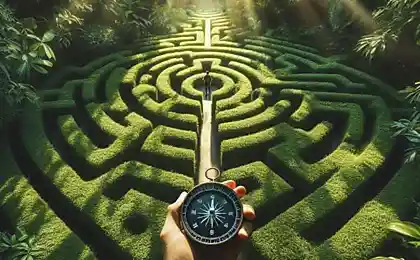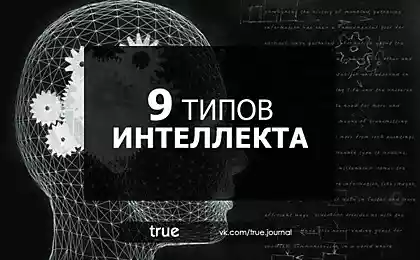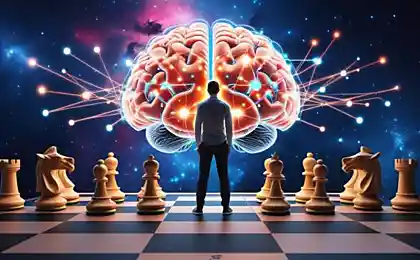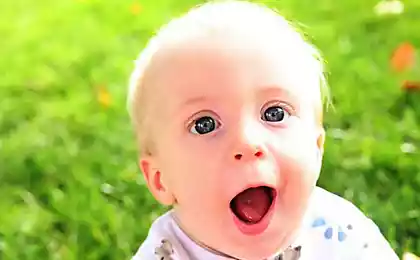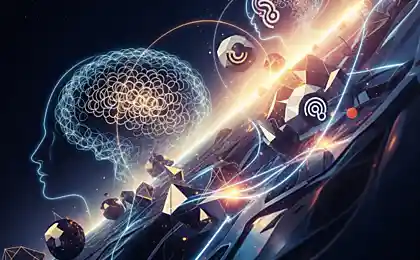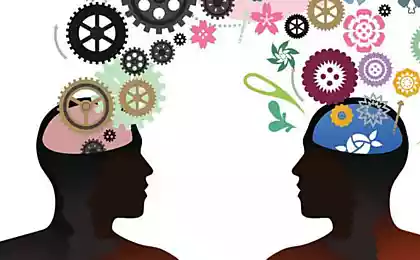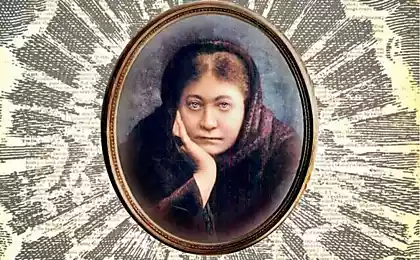728
5 types of thinking
Thinking is a tool and it can be different. Each of the “thinking” has its own scope, boundaries, and connection with other tools. Published a very concise and informative summary of the book "the famous five. Thinking strategies leading to success."
Howard Gardner distinguishes 5 types of thinking, and using which people can boldly look into the future, and, if necessary, to cope with difficulties, anticipate the impossible. The purpose of the book is to talk about how to develop these types of thinking.
1) disciplinary type
2) synthesizing type
3) creative type
4) aspectological type
5) ethical type

Disciplinary type of thinking
People usually do not understand the difference between subject and discipline as a rule, study items. Discipline is a completely different phenomenon. It involves a characteristic way of thinking, vision of the world. Science observes the world, generates concepts, theories, experimentally verifies, develops, in the light of new discoveries, and then, armed with new knowledge, undertaking further observation, creates a new classification puts new experiences.
People who have mastered the scientific way of thinking, know that any scientific belief will sooner or later be questioned, because to be a new discovery or revolutionary theory.
It is obvious that for occupations in the natural Sciences, history, literature, any discipline, people need information, but without communication with each other, without the underlying issues, the disciplinary method of explanation of this body of information, the facts simply remain "inert knowledge."
In other words, students must perceive the information not as an independent value, not as a launching platform for more complex information and as a tool that will help to act effectively, based on knowledge.For its part, the teachers are acting, including as teachers, should seek the student's response to guide their abilities in the right direction, to students have developed professionalism in the field of thinking and behavior.
How to develop disciplinary thinking
To start learning, it is necessary to identify the objectives and interests of the person, and then simulate the way of thinking.
For development you must pass 4 stages:
1. To identify the most important issues or concepts within the discipline
2. To spare time for training
3. To consider each topic from different points of view
4. Set the parameters of understanding
It should be remembered that any form of thinking can take excessive forms. Don't need to professional thinking penetrated all areas of your life.
People need to know about the limitations of the development of their disciplines
This person can help the mastery of multiple disciplines. Of course, you should be aware of the context of perception of the phenomenon from a particular point of view, depending on the conditions.
You cannot have discipline obsessed for the sake of discipline. So if a person is a true scholar of law, he won't just acquainted with each published report and to boast of his knowledge. This behavior is a sign of immaturity, and unprofessionalism.
Remember that any knowledge you can not learn fully without the involvement of related disciplines. People should be objective in how deeply he knows one or even several disciplines. Make this is a must. Disciplinary methods should be tools, not shackles.
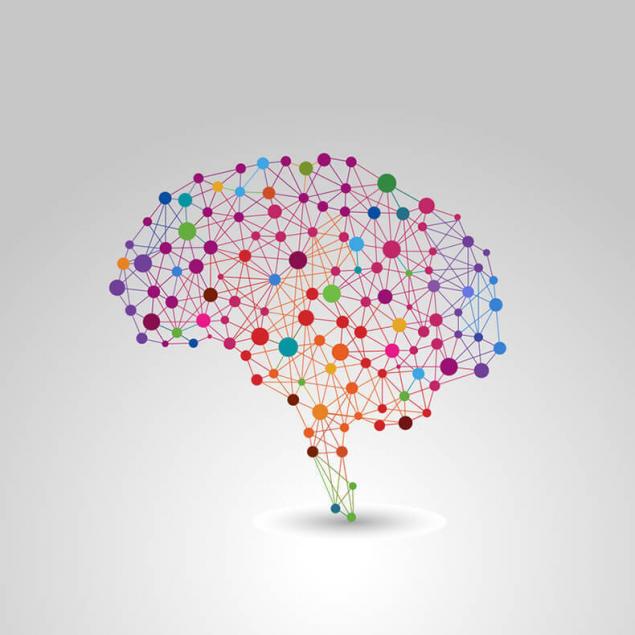
Synthesizing mindset
The ability to tie together information from disparate sources is vital today. The amount of accumulated knowledge doubles every 2-3 years, sources of information are extensive, they are not similar to each other, and people looking for a connection between them, trying to integrate.
However, the path to the ability to synthesize very difficult. All complicated by the fact that human cognitive abilities are largely dependent on subject area. We are predisposed to acquire skills in context and resist their generalization to wider use.
Types of synthesis:
1. Presentation — integrating material into a coherent story (examples from the Bible to modern books on history and social Sciences).
2. Taxonomy — structured materials on the basis of significant characteristics. Systematics is often present in graphs and tables. Examples, classification of plants and animals Linnaeus.
3. Integrated concept – the combination of different phenomena. Examples, the concept of natural selection, the concept of the unconscious Freud, the 5-factor model of porter.
4. Sayings and aphorisms
5. Strong metaphors, images and themes. To describe the concepts and ideas are frequently used metaphors.
6. Visual and musical images.
7. Theory. The concept can be converted into a theory. For example, the theory of evolution combines Darwin's concept of variation, struggle for existence, natural selection, survival and reproduction.
8. Meta-theory. Knowledge can be embedded in a General framework, "theory of theories". So, Hegel portrayed the universal sequence of development from thesis to antithesis and to synthesis.
The components of the synthesis
Effective synthesis of information is a serious task. Every attempt integration should include 4 components:
1. The goal is formulation of the concept that you are trying to create with the synthesis.
2. Starting point-an idea, an image, any work prior to synthesis.
3. The choice of strategy, methods and approach.
4. Projects and sketches. Sooner or later, the person engaged in the synthesis, have to take the first step.
Examples of works whose authors have used a synthesized type of thinking:
Synthesis is a difficult task, but solvable. Prevents the synthesis of conservatism in our thinking. The life of people largely depends on the circumstances, we learn to act, behave and think in certain conditions.
As they grow, we maintain the ability to act and think in exactly those circumstances in which we acquired these skills in situations not similar to the situation of learning. Such conservatism does not prevent a person to learn a separate discipline, but prevents the mastery of an interdisciplinary approach or an art class.
The author distinguishes two kinds of intelligence. Both types of intelligence are capable of synthesis, however, what type of information they will synthesize and success criteria and synthesis are different.
1. laser intelligence — penetrates deep into the subject, however, can easily move from one subject to another, more suitable for the study of separate disciplines.
2. searchlight intelligence — does not penetrate as deeply, but constantly explores the environment, and therefore more readily observed when (and find differences) between different fields of knowledge.
How to make the synthesis successful
A full synthesis involves a mixture of scripts, plans, concepts that are usually treated separately. It is a kind of art of creating combinations.
People who can present an idea or concept in multiple ways. More capable of effective synthesis than those who have only limited, sometimes fuzzy idea of the idea.
To ensure that the synthesis was successful required a clear strategy for its implementation. You need to define:

Creative mindset
The ability to generate new ideas and concepts, to find a nontrivial solution of actual problems, to answer new questions and to explain new phenomena. Rethinking creativity.
To understand creativity is a very important idea psychologist Mihaly of Csikszentmihaly, namely, that creative achievements are never credited to any single person or even a group of people. Rather creativity arises by chance as a result of the interaction of three Autonomous elements.
1. The person who has mastered some discipline and constantly working in this area (e.g., historian, composer, programmer and so on).
2. Professional domain in which the works of this man, with his characteristic cultural patterns in the framework of the accepted and rejected (views of what constitutes scientific work, musical work, the program).
3. Social environment — people and institutions that provide access to adequate education and the opportunity to work. Representatives of the environment evaluated the merits of the person and/or his creative attempts.
Csikszentmihaly, creativity takes place then and only when the product is created by a person or group, is recognized as innovative in a particular cultural domain, the appropriate environment and, in turn, sooner or later, has a unique and measurable impact on subsequent work in that domain.
This approach is applicable to various types of creativity different degrees of innovation.
Creativity and synthesis
The purpose of the person engaged in the synthesis, is to present what already exists in the most clear and convenient form. The purpose of the creative person to expand the boundaries of knowledge, to violate the laws of the genre, to direct their efforts in a new, uncharted direction.
Creative type of thinking goes beyond disciplinary knowledge and synthesis, raises new questions, offers new solutions. Creativity is an add-on to one or several disciplines and requires a competent entourage, which will be able to judge its innovativeness and affordability.
Aspectological type of thinking
The ability to accept different cultures, respect people regardless of their racial, national, professional belonging, the willingness to interact with various types of individuals and social structures. (education).
The desire to understand their peers, teachers, other people and to work effectively with them, whatever their origin and cultural identity. Examples (work). Ability to communicate effectively with colleagues, managers, employees, regardless of their origin and status.
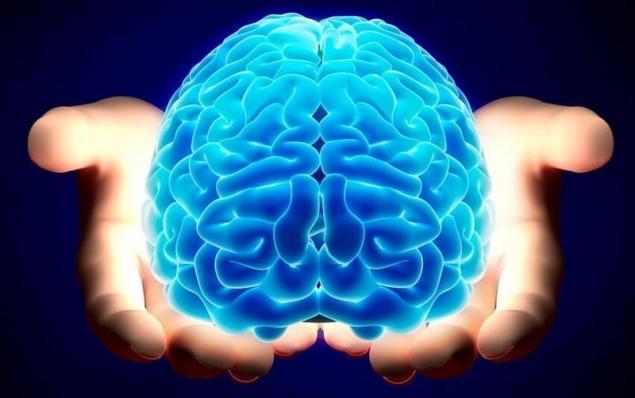
Ethical mindset
And work and social life requires that people looked at your life under a new wide angle. He needs to answer the following questions:
Peter senge: "If we aspire to goals more than our interests, seek to know that the wider our awareness, the only possible decision — to stand on an ethical position. An ethical position requires that we abandon the personal point of view and become impartial observers. Thus, looking at things morally, you go beyond domestic considerations and identify yourself with the most objective possible points of view." Describing this type of thinking, the author reveals the concept of decent work. Work can be called worthy, if it is of excellent quality (vysokopillya), when taken into account the interests of all stakeholders and the communities in which the company operates, when it is a pleasure (fun), meaningful and profitable. In General, if the man be a worker depends on his desire to work well, the desire to achieve a goal, especially if it's not easy.
The author identifies 4 areas that should be considered by people who want to work with dignity:
1. Mission. In school and after school, studying or working, the person must know what he wants to achieve. Without a clear knowledge of their goals, people will likely not be able to determine in which direction to move.
2. Examples. It is very important to take an example — better to have decent people, but we can through books or the media - people who embody a quality employee. If no such examples, a young officer hard to move forward. Sometimes a negative example can also teach the necessary lesson.
3. Self-criticism. The young employee must sometimes look at ourselves and evaluate their own actions. You need to ask yourself the question: "how Well do I work, and if not, what can I do to make work better?". Since we all tend to close their eyes to its drawbacks, you need to listen to the opinion of competent and impartial people.
4. Professional liability.
Intelligence is not the main thing: How geniuses think
Emotional intelligence: key considerations for development
Ethical type — awareness of the need to implement human, civil and professional duties and take responsibility for their own actions in any of these areas. Provides for consistent implementation of moral principles in work and life.
Examples (education): Thinking about your role as a student and future professional and the desire to fulfill that role properly and with the necessary responsibility.
Examples (work): knowledge of the basic values of the profession and the desire to support and promote them even during rapid and unpredictable change. The sense of responsibility for the profession, a willingness to Express their opinion even to the detriment of themselves. The recognition and fulfillment of the duties of a citizen of the community, region, country, world.
Pseudoform: In the words of man seem to be a good employee and a responsible citizen, but his words with deeds. Such a person is prone to unacceptable compromises in work and public life.published
Author: Howard Gardner
Text: Elena Eremeeva
Source: www.facebook.com/notes/%D0%BA%D0%BE%D1%84%D0%B5-%D0%B1%D1%80%D0%B5%D0%B9%D0%BA-%D1%81-%D1%84%D0%B8%D0%BB%D0%BE%D1%81%D0%BE%D1%84%D0%BE%D0%BC/5-%D1%82%D0%B8%D0%BF%D0%BE%D0%B2-%D0%BC%D1%8B%D1%88%D0%BB%D0%B5%D0%BD%D0%B8%D1%8F/1746857008888916
Howard Gardner distinguishes 5 types of thinking, and using which people can boldly look into the future, and, if necessary, to cope with difficulties, anticipate the impossible. The purpose of the book is to talk about how to develop these types of thinking.
1) disciplinary type
2) synthesizing type
3) creative type
4) aspectological type
5) ethical type

Disciplinary type of thinking
People usually do not understand the difference between subject and discipline as a rule, study items. Discipline is a completely different phenomenon. It involves a characteristic way of thinking, vision of the world. Science observes the world, generates concepts, theories, experimentally verifies, develops, in the light of new discoveries, and then, armed with new knowledge, undertaking further observation, creates a new classification puts new experiences.
People who have mastered the scientific way of thinking, know that any scientific belief will sooner or later be questioned, because to be a new discovery or revolutionary theory.
It is obvious that for occupations in the natural Sciences, history, literature, any discipline, people need information, but without communication with each other, without the underlying issues, the disciplinary method of explanation of this body of information, the facts simply remain "inert knowledge."
In other words, students must perceive the information not as an independent value, not as a launching platform for more complex information and as a tool that will help to act effectively, based on knowledge.For its part, the teachers are acting, including as teachers, should seek the student's response to guide their abilities in the right direction, to students have developed professionalism in the field of thinking and behavior.
How to develop disciplinary thinking
To start learning, it is necessary to identify the objectives and interests of the person, and then simulate the way of thinking.
For development you must pass 4 stages:
1. To identify the most important issues or concepts within the discipline
2. To spare time for training
3. To consider each topic from different points of view
4. Set the parameters of understanding
It should be remembered that any form of thinking can take excessive forms. Don't need to professional thinking penetrated all areas of your life.
People need to know about the limitations of the development of their disciplines
This person can help the mastery of multiple disciplines. Of course, you should be aware of the context of perception of the phenomenon from a particular point of view, depending on the conditions.
You cannot have discipline obsessed for the sake of discipline. So if a person is a true scholar of law, he won't just acquainted with each published report and to boast of his knowledge. This behavior is a sign of immaturity, and unprofessionalism.
Remember that any knowledge you can not learn fully without the involvement of related disciplines. People should be objective in how deeply he knows one or even several disciplines. Make this is a must. Disciplinary methods should be tools, not shackles.

Synthesizing mindset
The ability to tie together information from disparate sources is vital today. The amount of accumulated knowledge doubles every 2-3 years, sources of information are extensive, they are not similar to each other, and people looking for a connection between them, trying to integrate.
However, the path to the ability to synthesize very difficult. All complicated by the fact that human cognitive abilities are largely dependent on subject area. We are predisposed to acquire skills in context and resist their generalization to wider use.
Types of synthesis:
1. Presentation — integrating material into a coherent story (examples from the Bible to modern books on history and social Sciences).
2. Taxonomy — structured materials on the basis of significant characteristics. Systematics is often present in graphs and tables. Examples, classification of plants and animals Linnaeus.
3. Integrated concept – the combination of different phenomena. Examples, the concept of natural selection, the concept of the unconscious Freud, the 5-factor model of porter.
4. Sayings and aphorisms
5. Strong metaphors, images and themes. To describe the concepts and ideas are frequently used metaphors.
6. Visual and musical images.
7. Theory. The concept can be converted into a theory. For example, the theory of evolution combines Darwin's concept of variation, struggle for existence, natural selection, survival and reproduction.
8. Meta-theory. Knowledge can be embedded in a General framework, "theory of theories". So, Hegel portrayed the universal sequence of development from thesis to antithesis and to synthesis.
The components of the synthesis
Effective synthesis of information is a serious task. Every attempt integration should include 4 components:
1. The goal is formulation of the concept that you are trying to create with the synthesis.
2. Starting point-an idea, an image, any work prior to synthesis.
3. The choice of strategy, methods and approach.
4. Projects and sketches. Sooner or later, the person engaged in the synthesis, have to take the first step.
Examples of works whose authors have used a synthesized type of thinking:
- Bill Bryson "a short history of everything"
- Ken Wilber "a brief history of everything"
Synthesis is a difficult task, but solvable. Prevents the synthesis of conservatism in our thinking. The life of people largely depends on the circumstances, we learn to act, behave and think in certain conditions.
As they grow, we maintain the ability to act and think in exactly those circumstances in which we acquired these skills in situations not similar to the situation of learning. Such conservatism does not prevent a person to learn a separate discipline, but prevents the mastery of an interdisciplinary approach or an art class.
The author distinguishes two kinds of intelligence. Both types of intelligence are capable of synthesis, however, what type of information they will synthesize and success criteria and synthesis are different.
1. laser intelligence — penetrates deep into the subject, however, can easily move from one subject to another, more suitable for the study of separate disciplines.
2. searchlight intelligence — does not penetrate as deeply, but constantly explores the environment, and therefore more readily observed when (and find differences) between different fields of knowledge.
How to make the synthesis successful
A full synthesis involves a mixture of scripts, plans, concepts that are usually treated separately. It is a kind of art of creating combinations.
People who can present an idea or concept in multiple ways. More capable of effective synthesis than those who have only limited, sometimes fuzzy idea of the idea.
To ensure that the synthesis was successful required a clear strategy for its implementation. You need to define:
- the aim and purpose synthesis
- the desired result
- a set of synthesis tools
- methods of estimation of intermediate results and the criteria by which to judge the success or failure of the project as a whole.

Creative mindset
The ability to generate new ideas and concepts, to find a nontrivial solution of actual problems, to answer new questions and to explain new phenomena. Rethinking creativity.
To understand creativity is a very important idea psychologist Mihaly of Csikszentmihaly, namely, that creative achievements are never credited to any single person or even a group of people. Rather creativity arises by chance as a result of the interaction of three Autonomous elements.
1. The person who has mastered some discipline and constantly working in this area (e.g., historian, composer, programmer and so on).
2. Professional domain in which the works of this man, with his characteristic cultural patterns in the framework of the accepted and rejected (views of what constitutes scientific work, musical work, the program).
3. Social environment — people and institutions that provide access to adequate education and the opportunity to work. Representatives of the environment evaluated the merits of the person and/or his creative attempts.
Csikszentmihaly, creativity takes place then and only when the product is created by a person or group, is recognized as innovative in a particular cultural domain, the appropriate environment and, in turn, sooner or later, has a unique and measurable impact on subsequent work in that domain.
This approach is applicable to various types of creativity different degrees of innovation.
Creativity and synthesis
The purpose of the person engaged in the synthesis, is to present what already exists in the most clear and convenient form. The purpose of the creative person to expand the boundaries of knowledge, to violate the laws of the genre, to direct their efforts in a new, uncharted direction.
Creative type of thinking goes beyond disciplinary knowledge and synthesis, raises new questions, offers new solutions. Creativity is an add-on to one or several disciplines and requires a competent entourage, which will be able to judge its innovativeness and affordability.
Aspectological type of thinking
The ability to accept different cultures, respect people regardless of their racial, national, professional belonging, the willingness to interact with various types of individuals and social structures. (education).
The desire to understand their peers, teachers, other people and to work effectively with them, whatever their origin and cultural identity. Examples (work). Ability to communicate effectively with colleagues, managers, employees, regardless of their origin and status.

Ethical mindset
And work and social life requires that people looked at your life under a new wide angle. He needs to answer the following questions:
- What means to be a lawyer/doctor/engineer/teacher?
- What are my rights and responsibilities?
- What it means to be a citizen of my community/region/planet?
- Whether I'm in front of others, especially to those. Who for various reasons lives worse?
Peter senge: "If we aspire to goals more than our interests, seek to know that the wider our awareness, the only possible decision — to stand on an ethical position. An ethical position requires that we abandon the personal point of view and become impartial observers. Thus, looking at things morally, you go beyond domestic considerations and identify yourself with the most objective possible points of view." Describing this type of thinking, the author reveals the concept of decent work. Work can be called worthy, if it is of excellent quality (vysokopillya), when taken into account the interests of all stakeholders and the communities in which the company operates, when it is a pleasure (fun), meaningful and profitable. In General, if the man be a worker depends on his desire to work well, the desire to achieve a goal, especially if it's not easy.
The author identifies 4 areas that should be considered by people who want to work with dignity:
1. Mission. In school and after school, studying or working, the person must know what he wants to achieve. Without a clear knowledge of their goals, people will likely not be able to determine in which direction to move.
2. Examples. It is very important to take an example — better to have decent people, but we can through books or the media - people who embody a quality employee. If no such examples, a young officer hard to move forward. Sometimes a negative example can also teach the necessary lesson.
3. Self-criticism. The young employee must sometimes look at ourselves and evaluate their own actions. You need to ask yourself the question: "how Well do I work, and if not, what can I do to make work better?". Since we all tend to close their eyes to its drawbacks, you need to listen to the opinion of competent and impartial people.
4. Professional liability.
Intelligence is not the main thing: How geniuses think
Emotional intelligence: key considerations for development
Ethical type — awareness of the need to implement human, civil and professional duties and take responsibility for their own actions in any of these areas. Provides for consistent implementation of moral principles in work and life.
Examples (education): Thinking about your role as a student and future professional and the desire to fulfill that role properly and with the necessary responsibility.
Examples (work): knowledge of the basic values of the profession and the desire to support and promote them even during rapid and unpredictable change. The sense of responsibility for the profession, a willingness to Express their opinion even to the detriment of themselves. The recognition and fulfillment of the duties of a citizen of the community, region, country, world.
Pseudoform: In the words of man seem to be a good employee and a responsible citizen, but his words with deeds. Such a person is prone to unacceptable compromises in work and public life.published
Author: Howard Gardner
Text: Elena Eremeeva
Source: www.facebook.com/notes/%D0%BA%D0%BE%D1%84%D0%B5-%D0%B1%D1%80%D0%B5%D0%B9%D0%BA-%D1%81-%D1%84%D0%B8%D0%BB%D0%BE%D1%81%D0%BE%D1%84%D0%BE%D0%BC/5-%D1%82%D0%B8%D0%BF%D0%BE%D0%B2-%D0%BC%D1%8B%D1%88%D0%BB%D0%B5%D0%BD%D0%B8%D1%8F/1746857008888916
Fake eggs from China: how to do it and how to spot a fake
24 the most effective exercises on the fitball, which will strengthen your body

